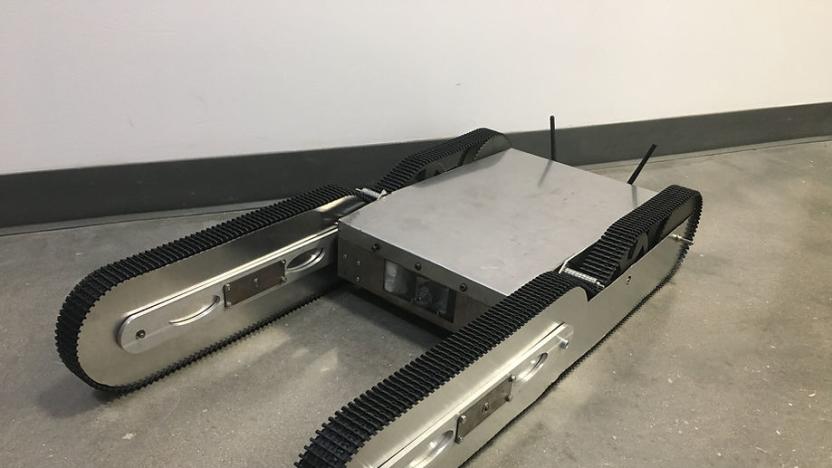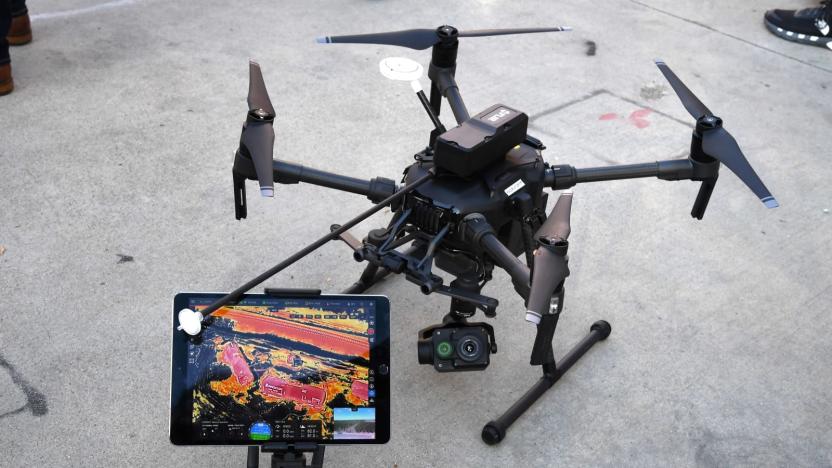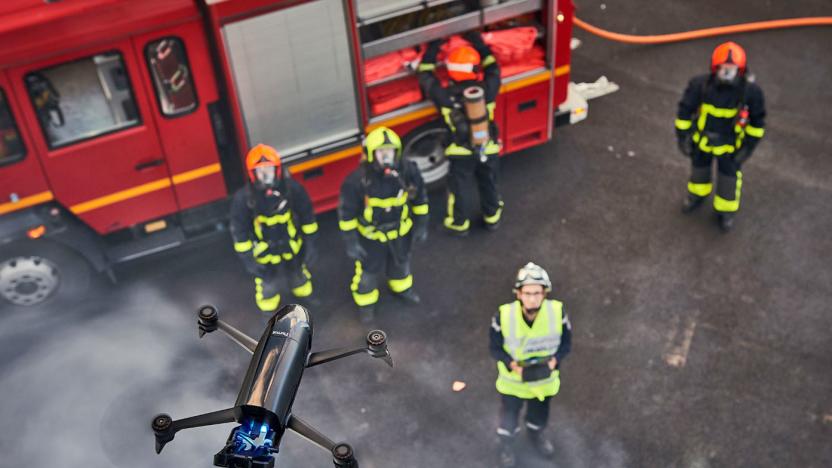firefighting
Latest

This $90,000 fireproof tankbot will scout burning buildings for people to save
FireBot, a remote-controlled robot that can withstand temperatures as high as 650 degrees Celsius, is hoping to make scoping dangerous scenes safer for firefighters.

Los Angeles Fire Department wants to double its drone fleet
It's not just law enforcement finding success with drones. The Los Angeles Fire Department's Battalion Chief Richard Field told TechCrunch that he intended to double the drone fleet just five months after a partnership with DJI began. On top of the existing 11 drones, the new ones would provide help to "specialized resources," such as crews who deal with hazardous materials, urban search and rescue and swift water rescues. Existing units provide clearer viewpoints on blazes and help create maps for wildfires.

Parrot's latest drones are for farmers and firefighters
It's been a tough year for Parrot. The drone maker cut 290 jobs after sub-par sales, and it wasn't shy in admitting that its lineup was both unfocused and (for personal drones) unprofitable. However, it has an idea as to how to recover: by targeting the professional crowd. Its new Bebop-Pro Thermal and Bluegrass drones include equipment tailored to specific needs. The Bebop, as its name implies, includes a thermal imaging camera and matching software alongside the usual video cam. It's meant to help firefighters and rescue crews pinpoint sources of heat, whether it's a blaze or a person trapped under rubble. There's also a long-range remote control in the box to keep pilots well out of harm's way.

ICYMI: Wildland firefighting is about to get an AI assist
try{document.getElementById("aol-cms-player-1").style.display="none";}catch(e){}Today on In Case You Missed It: Lockheed Martin just demonstrated its AI aircraft system that can spot fires and put them out independent of human intervention, while also checking to see if any humans were left behind near danger. The system is supposed to be in service within five years. Researchers discovered that Goffin cockatoos are smart enough to make tools from various materials, judging how long and narrow they need to be each time to pass through a hole and also reach a treat. Meanwhile, if you're interested in the rapid repair of a sinkhole in Japan, the timelapse video is here. There have been a lot of interesting stories this week but people will be talking about the judge's decision to allow a dying girl to be cryogenically frozen for quite a while. As always, please share any interesting tech or science videos you find by using the #ICYMI hashtag on Twitter for @mskerryd.

ICYMI: Water-repellent coating, elite air travel and more
#fivemin-widget-blogsmith-image-590267{display:none;} .cke_show_borders #fivemin-widget-blogsmith-image-590267, #postcontentcontainer #fivemin-widget-blogsmith-image-590267{width:570px;display:block;}try{document.getElementById("fivemin-widget-blogsmith-image-590267").style.display="none";}catch(e){}Today on In Case You Missed It: Rice University scientists came up with a new kind of water-repellent coating that is modeled on the lotus leaf. Australians have their first ever remotely controlled firefighting robot that is capable of firing a water cannon up to 90 feet. And Windspeed Technologies, an aerospace engineering firm, just upped the luxe travel game by putting a dome at the top of an aircraft with top 'o the plane seating for those you can pay for it.

Drone fights fires by dropping flaming balls
The thought of a fire-starting robot would normally have us fleeing in terror, but we'll make an exception for this one. Researchers are developing a drone, the Unmanned Aerial System for Fire Fighting (UAS-FF), that helps contain and prevent fires by dropping ping pong-sized flaming balls. If you need to burn grass before it fuels an uncontrolled blaze, you just program the drone to drop its chemically-ignited cargo in a specific pattern -- you don't have to send in a costly aircraft or face the risks of starting fires on the ground. It'll be a while before you see UAS-FF in service, but it's already nice to see a drone that helps firefighting instead of getting in the way. [Image credit: Craig Chandler/University Communications]

Authorities test autonomous helicopter's firefighting capabilities
Lockheed Martin's and Kaman's K-MAX helicopters are known for pilotlessly transporting cargo in Afghanistan, but it might soon be saving lives and nature in the US, as well. The companies have demonstrated an autonomous K-MAX with firefighting capabilities in front of federal officials on October 14th near Boise, Idaho. While there was a pilot onboard during the flight, he had his hands up most of the time, indicating that the aircraft can fly on its own. Within an hour-and-a-half, the chopper completed seven tasks, including scooping up water and dropping it on targets.

US Navy's firefighting robot finally appears (with a trusty sidekick)
SAFFiR, the humanoid firefighting robot that the US Navy and Virginia Tech engineers have been developing for years, is now more than just a blueprint. In fact, the military division has already demonstrated what the biped can do aboard one of its decommissioned ships. During a series of tests conducted in November 2014, it worked well enough to navigate uneven floors (extremely difficult for humanoid machines), identify equipment using thermal imaging and handle a hose to put out small fires. The Shipboard Autonomous Firefighting Robot did need a bit of help from a sidekick, though. No, not the firefighting snakebot Anna Konda (which is unfortunate, if you think they're the perfect pair), but a small drone created by Carnegie Mellon's Robotics Institute.

Watch an unmanned helicopter put out fires with help from a drone
Fighting wildfires is sometimes a daunting prospect with manned aircraft; pilots can't always fly around the clock or cover every patch of land. They won't have to if Lockheed Martin's efforts pan out. It recently demonstrated a tweaked version of its unmanned K-MAX helicopter that can work in tandem with a quadrotor drone, Indago, to stamp out fires with relatively little human intervention. As you'll see in the clip below, Indago serves as a forward scout that marks any hotspots. After that, K-MAX swoops in with a bucket to douse the flames. It fetches more water on its own, too.

SAFFiR: the autonomous, firefighting humanoid robot
It took six years, but at long last, Anna Konda has a formidable firefighting partner. SAFFiR, also known as the Shipboard Autonomous Firefighting Robot, is being shaped by scientists at the Naval Research Laboratory. As the story goes, it's a humanoid robot that's being engineered to "move autonomously throughout the ship, interact with people, and fight fires, handling many of the dangerous firefighting tasks that are normally performed by humans." Outside of being stoic (and brawny) from tip to tip, it's also outfitted with multi-modal sensor technology for advanced navigation and a sensor suite that includes a camera, gas sensor, and stereo IR camera to enable it to see through smoke. We're told that its internal batteries can keep it cranking for a solid half-hour, while being capable of manipulating fire suppressors and throwing propelled extinguishing agent technology (PEAT) grenades. Wilder still, it'll be able to balance in "sea conditions," making it perfect for killing flames while onboard a ship. Of course, it's also being tweaked to work with a robotic team, giving it undercover powers to eventually turn the flames on the folks that created it. Paranoid? Maybe. But who are we to be too careful?Update: Turns out, the same Dr. Hong that we had on The Engadget Show is responsible for this guy as well. It's the next step in evolution of the CHARLI humanoid, and the two photos seen after the break are credited to RoMeLa: Robotics & Mechanisms Laboratory, Virginia Tech.

Real Heroes: Firefighter finds real publisher
Conspiracy Entertainment obviously wants to ensure that there'll be none of this fake hero business on the Wii, because it's gone and signed up Epicenter Studios' Real Heroes: Firefighter, which it intends to release in the U.S. during Q2, 2009. Because it's been almost a year since we heard anything about the project, this morning's press release kindly reminds us that Real Heroes: Firefighter will utilize the Wii Remote as a fire hose, a fire axe, and a crowbar, all in the name of fighting Epicenter's proprietary "Thinking Fire" technology. Conspiracy CFO Keith Tanaka was also on hand with some quotes about product line-ups and distribution, for which we thank him and move on.[Via press release]

Latest Simple DS shots show off firefighting, surgery
The latest two offerings in D3 Publisher's Simple DS line-up manage to look both gross (Simple DS Series Vol. 40: THE Gekai) and dramatic (Simple DS Series Vol. 39: THE Shouboutai) in these new screens.More ER than Scrubs, THE Gekai (The Surgeon) takes a far more serious approach to surgery than Trauma Center. It might be worth a closer look come June, but for now we're far more interested in THE Shouboutai (The Firefighting Crew), partially because there's nothing quite like it on the DS (there should be more games about firefighting anyway, given that it oozes with the potential for drama and heroism), and also because our addled memories still fondly recall Burning Rangers on the Saturn. Actually, Burning Rangers is the main reason we're interested in this. Okay, the only reason. We wouldn't count on D3's firefighters carrying jet-packs, mind.Head to our new galleries for the fresh screenage, though don't be expecting either of these to make the journey west.%Gallery-22325%%Gallery-22327%

Perform simple surgery, fight simple fires
In June, Japan will have two more additions to D3's Simple DS series. One will be a Trauma Center type of game, but with more realistic looking organs. Also, you'll be operating to cure actual conditions, like appendicitis, rather than mysterious, made-up outbreaks. We'll squeamishly take our cartoon organs, thanks, but should you have a stomach for that sort of thing, Simple DS Series Vol. 40: The Gekai might be the game for you.The other simple software, Vol. 39: The Shouboutai, deals with the heroic task of firefighting. Since poking at fires with your stylus is less dangerous than dashing into burning buildings, D3's game probably sounds more appealing than the real-life task.

"Robot" firefighters get put into service
We've seen robot firefighters before, and even a robot firefighting contest, but it looks like some brave bots from the folks at Qinetiq are among the first to actually see service, although their roles are decidedly limited for the time being. According to Popular Mechanics, the robots are only being used to put out fires involving Acetylene gas, which had previously simply been left to burn themselves out due to the risk of explosions. With the bots, however, they're able get things moving along far more quickly, which is especially useful when the blaze is causing train delays. It seems that's a job too big for just one robot, however, as Qinetiq has reportedly been commissioned to put three bots into service during a six month trial period, including a Talon bot that uses thermal imaging to asses the situation, a 2,160-pound Brokk 90 robot that can "tear through walls or shove vehicles out the way," and last but not least the ATV-sized "Black Max" that actually douses the situation. Sadly, it seems that the bots are all remotely-controlled for the time being, and not fully autonomous, but we're sure it's only a matter of time before they really get to show what they're capable of.

i-Garment's "smart suit" helps disaster relief agents
Designed to help firefighters communicate independently of unreliable traditional systems such as cellphone networks, i-Garment's "smart suit" does more than just enable voices to be heard. The suit also packs in location and health monitoring, with a whole infrastructure behind it including multiple stages from the field vehicle back to HQ. The European Space Agency recently approved the suit after a series of tests including firefighting scenarios: it's not currently planned for the US, but it wouldn't be surprising to see this or a similar system over here sometime soon.[Thanks, Michelle. Via InventorSpot]

Hold the hose real tight and get ready for a real fight
A new developer called Epicenter Games is developing a non-violent firefighting action-puzzle game for the Wii, called Real Heroes: Firefighters. The title should help prevent confusion with those other Real American Heroes. Real Heroes casts players as a new firefighter in a busy station, and, of course, uses the Wiimote to simulate a fire hose.The game makes use of what Epicenter calls "Thinking Fire," which will totally beat you at Othello react unexpectedly and semi-randomly to your actions. The game doesn't have a publisher yet, but they're hoping for a release in late 2008.

Ubiko nursebot retasked with sniffing out fires
One of the many ways in which robotic laborers are superior to their human counterparts is their ability to be easily re-purposed: one day you're an underpaid, under-appreciated nursebot chain-smoking with your co-workers in the break room, and the next day you're equipped with some new peripherals and tasked with ratting out those very same smokers along with other potential fire hazards. Such is the life of a Tmsuk-manufactured robot named Ubiko, who was snatched away from its budding career as an unassuming hospital receptionist by researchers from Kyushu University and the Kanazawa Institute of Technology, and retrofitted with a unique olfactory sensor programmed to recognize the distinctive odors of smoke and ash. This new electronic sniffer allows Ubiko to pick up scents too faint for the human proboscis to detect, giving it a "nose up" when it comes to tracking down small fires before they turn into raging infernos. Since the bot isn't equipped with any actual firefighting paraphernalia, its only job is wirelessly alerting authorities to potential problems and then scooting away before it melts into the floor; these so-called "authorities" then have the grueling task of pressing yet another button to deploy either an Anna Konda or SACI bot to make short work of the lit candle or smoldering cigarette butt.[Via Pink Tentacle]

Tactile display could convey signals on soldiers' backs
Although glitzy, stat-filled jerseys are certainly sufficient ways to get information off your chest (ahem), a new vibrating vest could give "body language" an entirely new meaning. Joining the air-conditioned and insulating renditions, this snazzy vest features a "tactile display" on the back, which is created by 16 small vibrating motors that are connected to an internal wireless control unit. The jacket "writes symbols and messages on its wearer's back," and while the actual writing resembles Braille more than text, it can supposedly be used to "send important commands to soldiers or firefighters, warning them of imminent danger when ordinary radios cannot be used." Commands are beamed to the vests via a wirelessly-enabled computer, and can stealthily inform platoons to stop, look in a specific direction, run, or slow down. The US Army is partially funding the research, as it hopes to investigate different ways to communicate when hand signals and / or radio transmissions aren't effective. During initial testing, results have shown nearly flawless interpretation by participants, and while we're not exactly sure when we can expect rumble-equipped gear to grace our armed forces, the problem of "excess noise from the motors" has to be quelled before hitting the battlefield.[Via BoingBoing]

ARMTEC's SACI firefighting robot
It seems the Foundation for Industrial and Scientific Research in Norway (SINTEF) isn't the only game in town, er, the world, out to make firefighters' jobs a lot easier (or endangered). Brazil's ARMTEC has crafted a water-blasting robot -- dubbed SACI -- that would make a warehouse of Super Soakers look like child's play. The bot, obviously immune to smoke, fear, and extreme heat, can quench flames in a trio of ways: a direct stream, foam blast, or a wide-reaching "mist" approach. To extinguish those hard-to-reach hot spots, it touts a maximum blast of 60 meters, and the cannon pivots from 20 - 70 degrees vertically while being wheeled around on the tank-like track system. Unlike the Anna Konda, which has motors powered by a regular fire hose, this remotely controlled machine requires batteries to maneuver itself around. But this fearless commander doesn't get burnt out quickly, as it can pump fluids for three solid hours before needing a recharge. So if your local fire department has too many flames to handle, and not enough men to keep things cool, snagging a tag-team of SACIs may be in order to beat the heat.[Via Robot Gossip]






